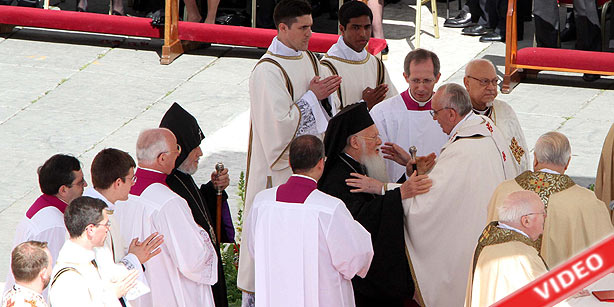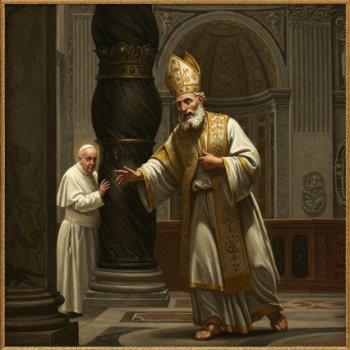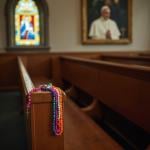
You’ve heard reports about the fact that the Ecumenical Patriarch Bartholomew’s attendance at the installation of Pope Francis was big news. It would be the first time it had happened in close to a thousand years, we were told. But what if it was the first time ever?
That’s what Professor George E. Demacopoulos, Historian for the Order of the St. Andrew Orthodox Christian Studies Center at Fordham University claims in an article published today on the Greek Orthodox Archdiocese of America website. Take a look,
The Extraordinary Historical Significance of Ecumenical Patriarch Bartholomew’s Presence at Pope Francis’ Installation as Bishop of Rome
Amid the crush of news reports in the past month that followed Pope Benedict’s unprecedented resignation from the papacy, one of the most intriguing was the decision by His All-Holiness, Ecumenical Patriarch Bartholomew, to attend Pope Francis’ installation as Bishop of Rome. The occasion is being presented in the media as something that has not happened since the ecclesiastical schism that separated Christian East and Christian West in the eleventh century. But that characterization is almost certainly wrong–this is quite likely the first time in history that a Bishop of Constantinople will attend the installation of a Bishop of Rome. And this is a profoundly bold step in ecumenical relations between the Orthodox and the Roman Catholics, one that could have lasting significance.
Prior to the sixth century, the election of a Roman bishop was a local affair. In most cases, the new pope was chosen from among the city’s clergy and was typically either the eldest priest or the eldest deacon. There were a few exceptions, but this was the typical pattern. News of an election would circulate throughout the Christian world but that news flow would have been too slow to enable high-ranking Church officials from the East to travel to Rome for the event.
During the sixth century, Byzantine armies conquered the Italian peninsula, returning the city of Rome to the imperial Roman government, now centered in Constantinople. In this context, which lasted from the mid-sixth century until the loss of Byzantine influence in Italy in the eighth century, the election of a new Roman bishop required the approval of the Byzantine emperor (the same, of course, was true of the election of a new Ecumenical Patriarch). Under such an arrangement, papal elections took longer but there still would be no reason for an Eastern Patriarch to travel to Rome for the installation.
There are a few examples from this Byzantine period, such as the election of Pope Pelagius I in 556, where the man elected to be the Roman bishop was actually in Constantinople at the time of his election. While it is possible that the sacramental ceremony to install the new pope could have occured in Constantinople–whereby the Patriarch of Constantinople would have been present–it is far more likely that the official ceremony would have occurred in Rome and, therefore, would have been conducted without the Patriarch’s presence.
At the conclusion of Byzantine influence in papal elections in the eighth century, the election of Roman bishops returned, again, to local considerations. And, as geo-political factors continued to push Italy and the Eastern empire in separate directions, relations between individual popes and patriarchs became more sterile and distant–indeed, between the ninth and fifteenth century there are only one or two occasions where a Roman bishop and an Ecumenical Patriarch ever met in person.
With all of this in mind, His All-Holiness’ decision to travel to Rome for Pope Francis’ installation as Roman bishop is an extraordinary event in the history of Christianity.
The photograph above is great, but it was even more exciting to see Pope Francis give His All-Holiness the precious Body and Blood of Our Lord by means of intinction of the sacred host during the Eucharistic Celebration. I never thought I would ever be a witness to that.*
God is good!
*See discussion below (and in the combox).
UPDATE:
I’m probably mistaken about our Orthodox brethren receiving Communion. Michelle Arnold of Catholic Answers shared this information a few years back,
<blockquote><a href=”http://old.usccb.org/liturgy/current/intercom.shtml”>The USCCB’s Guidelines for the Reception of Communion</a> state:
Members of the Orthodox churches, the Assyrian Church of the East, and the Polish National Catholic Church are urged to respect the discipline of their own churches. According to Roman Catholic discipline, the Code of Canon Law does not object to the reception of Communion by Christians of these churches (canon 844 § 3).
Basically, this means that the Catholic Church does not object to reception of Catholic Communion by Eastern Orthodox Christians, but urges those Christians to respect their own church’s sacramental discipline. To the best of my knowledge, Orthodox churches ordinarily strongly object to their members receiving Communion in a Catholic church. For example:
Q: As a Greek Orthodox may I receive the sacrament of Holy Communion in a Catholic Church? Do you know the rules regarding Greek Orthodox and Catholic relations? I live in an area where the closest church is a Roman Catholic Church. Does the Catholic Church recognize us as equals?
A. Orthodox Christians are not permitted to receive Communion in non-Orthodox communities, including the Roman Catholic. To do so would imply a unity that in fact does not yet exist. Also it implies that we are “united” to the faith community from which we receive the Eucharist.
In brief, while Roman Catholicism sees Orthodoxy as a “sister church,” Orthodoxy sees herself as the fullness of the Church, not the “other half” of the Church, as implied in the notion of a “sister church” (<a href=”http://oca.org/questions/romancatholicism/communion-in-roman-catholic-church”>source</a>).</blockquote>
<a href=”http://forums.catholic.com/showthread.php?t=205046″>See the thread at Catholic Answers</a>.















